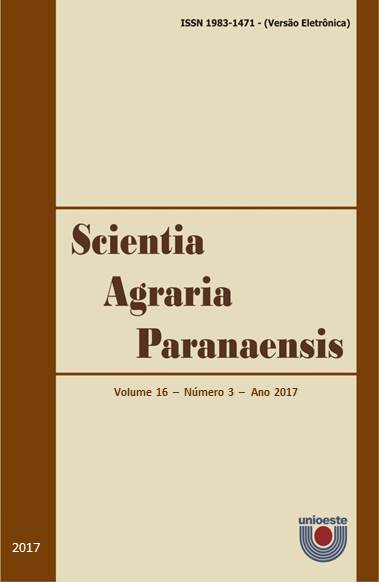Morphometry and stomatal conductance in seedlings of woody species as a function of irrigation frequency
Palavras-chave:
deficit hídrico, abertura estomática, espécies secundáriasResumo
Plant responses to reduced water availability are complex because they affect several processes of plant metabolism. The experiment aimed to quantify morphometry and stomatal conductance as a function of irrigation frequency at the end of production cycle of pau-marfim and guajuvira seedlings. The experiment was conducted in a shade house with the imposition of daily irrigation for 30 days, irrigation every other day for 30 days, irrigation every other day for 15 days and every four days for 15 days, and watering every other day for seven days and every four days for 23 days. The results indicated a decrease in stomatal conductance with an increase in the interval between daily irrigations in seedlings of pau-marfim and guajuvira while morphometric variables did not show sensitivity to the treatments.
Downloads
Publicado
Como Citar
Edição
Seção
Licença
Aviso de Direito Autoral Creative Commons
Política para Periódicos de Acesso Livre
Autores que publicam nesta revista concordam com os seguintes termos:
1. Autores mantém os direitos autorais e concedem à revista o direito de primeira publicação, com o trabalho simultaneamente licenciado sob a Licença Creative Commons Attribution que permite o compartilhamento do trabalho com reconhecimento da autoria e publicação inicial nesta revista.2. Autores têm autorização para assumir contratos adicionais separadamente, para distribuição não-exclusiva da versão do trabalho publicada nesta revista (ex.: publicar em repositório institucional ou como capítulo de livro), com reconhecimento de autoria e publicação inicial nesta revista.
3. Autores têm permissão e são estimulados a publicar e distribuir seu trabalho online (ex.: em repositórios institucionais ou na sua página pessoal) a qualquer ponto antes ou durante o processo editorial, já que isso pode gerar alterações produtivas, bem como aumentar o impacto e a citação do trabalho publicado (Veja O Efeito do Acesso Livre).
Licença Creative Commons
Esta obra está licenciada com uma Licença Creative Commons Atribuição-NãoComercial-CompartilhaIgual 4.0 Internacional, o que permite compartilhar, copiar, distribuir, exibir, reproduzir, a totalidade ou partes desde que não tenha objetivo comercial e sejam citados os autores e a fonte.


